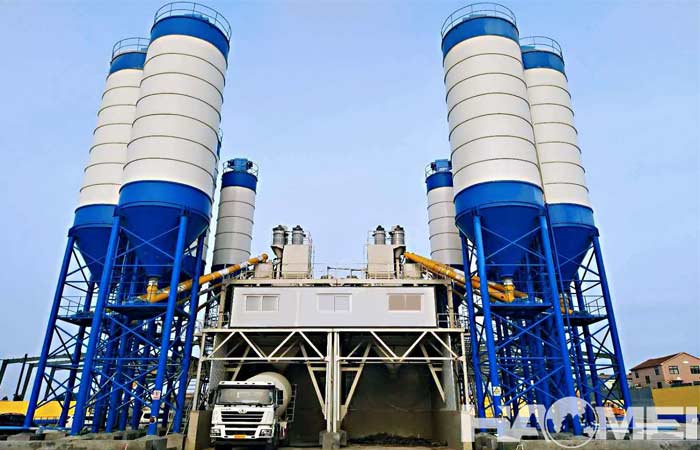Categories
- Case & News (50)
- Blog (561)
Large concrete mixing stations are industrial facilities used for centralized concrete production. They offer high efficiency, stability, and environmental friendliness. Their theoretical capacity typically exceeds 120 m³/h, with actual production capacities ranging from 100-200 m³/h. They are widely used in large infrastructure projects such as bridges, high-speed railways and reservoirs.

Large concrete mixing stations, centered around the HZS series, offer production capacities ranging from 120 to 240 m³/h, with annual production capacities ranging from approximately 150,000 to 600,000 m³. Specific models and production capacities are as follows:
HZS120: Theoretical output 120 m³/h, actual output 90-100 m³/h, annual production capacity approximately 250,000 m³.
HZS180: Theoretical output 180 m³/h, actual output 150-170 m³/h, annual production capacity approximately 350,000 m³.
HZS240: Theoretical output is 240 m³/h, actual output is 220-230 m³/h, with an annual production capacity of approximately 450,000 cubic meters.
Actual output is affected by factors such as loading and material availability, and is typically 70%-90% of the theoretical value. For example, the HZS180 concrete mixing station can reach 180 m³/h under ideal conditions, but in actual operation it may drop to 150-170 m³/h.
Structural Features of Large Concrete Mixing Station
– High-Efficiency Mixing System:
It utilizes a spiral twin-shaft forced mixing unit. The mixing blades are made of high-chromium alloy, which is wear-resistant. The shaft end seals feature multiple design features to reduce slurry leakage and extend equipment life.
The mixing process synchronizes mixing and hydration, shortening mixing time and improving uniformity.
– Precision Batching System:
Aggregate, cement, water, and admixtures are independently weighed with an accuracy of ±1%. Domestically renowned sensors and pneumatic butterfly valves are used to ensure precise proportioning.
The aggregate hopper is equipped with a vibrator for rapid discharge and reduced residue.
– Environmentally Friendly Conveying Design:
The enclosed inclined belt conveyor prevents dust and falling materials. Equipped with a sky-blue rainproof canopy and a pull-cord emergency stop switch, it balances aesthetics and safety.
An optional dust recovery system reduces environmental pollution.
– Low Energy Consumption and Maintenance Costs:
With low installed power and a reduced mixing volume, energy consumption is 15%-20% lower than traditional equipment.
With a simplified structure and short belts, the failure rate low, making maintenance easy.
Core Advantages of Large Concrete Mixing Station:
– High-Performance Mixing:
Suitable for dry, hard, plastic, and various mix ratios of concrete, achieving a mixing uniformity exceeding 98%, meeting the requirements of high-strength projects.
– Environmental Protection and Energy Saving:
The fully enclosed production process ensures dust emissions meet national standards. An optional dust removal system can be installed to further purify the air.
Energy consumption is 15%-20% lower than traditional equipment, with electricity consumption per cubic meter of concrete being approximately 1.2 kWh.
– Long Life and Reliability:
Key components (such as the screw conveyor and metering sensors) are made of high-quality materials and have a design life of over 10 years. The maintenance platform is strategically laid out, providing ample operating space and reducing downtime.
– Automation and Efficiency:
It supports fully automated batching, mixing, and discharging processes, increasing labor productivity by over 30% and reducing labor costs by 20%.
Typical Application Scenarios of Large Concrete Mixing Station:
– Large-Scale Infrastructure Projects:
Projects such as highways, bridges, and ports require a continuous supply of concrete. The HZS180 concrete batching plant, for example, can meet daily pouring requirements of 1,500 m³.
– Ready-Mixed Concrete Production:
Precast plants and commercial concrete plants require efficient and stable production. A dual-unit HZS120 concrete bathing plant can achieve an output of 240 m³/h, meeting the needs of medium-sized cities.
– Special Project Requirements:
Water conservancy projects and nuclear power plants require extremely high concrete quality. A forced mixing main unit ensures precise mixing ratios.
The total investment for a large concrete mixing station is typically high. Taking the HZS120 as an example, the equipment cost for a single line is approximately 150,000 dollars. With the addition of pump trucks and transport vehicles, the total investment is approximately 2 million dollars. The gross profit margin is approximately 30%, with a payback period of 3-5 years.